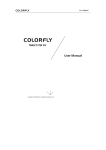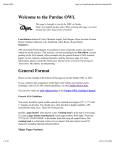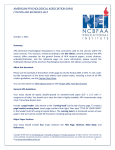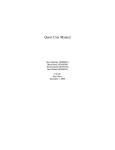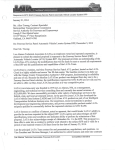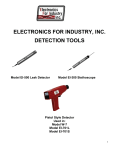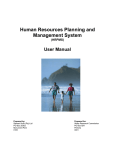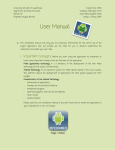Download this link - University of Waterloo
Transcript
Ok.com University of Waterloo Faculty of Environment Department of Environment and Resource Studies ENVIRONMENT AND RESOURCE STUDIES COOPERATIVE EDUCATION WORK REPORT GUIDELINES University of Waterloo Environment and Resource Studies Waterloo ON Firstname Lastname, ID 00000000 4A Environment and Resource Studies May 1, 2015 Firstname Lastname 1 First Street Streetsville ON L0L 0N0 May 1, 2015 Dr. Andrew Andrews, Undergraduate Chair Environment and Resource Studies University of Waterloo 200 University Avenue West Waterloo ON N2L 3G1 Dear Dr. Andrews, The enclosed report, entitled "Co-operative Education Work Report Guidelines" is my fourth (3B) work term report. Prepared for the University of Waterloo’s Environment and Resource Studies (ERS) Department, this document provides ERS co-operative education students with a comprehensive set of department-specific guidelines to follow while completing their own work term reports. During the Fall term of 2014 and Winter of 2015, I was employed as a Work Term Report Evaluator by the Department of Environment and Resource Studies. Under the supervision of Barbara Brown, Undergraduate Program Advisor, I completed this update to the September 2014 edition of the ERS work report guidelines, in conjunction with a Winter 2015 transition to electronic work report submissions. The new guidelines will come into effect for students on work term during the Spring 2015 term, and submitting for the September 2015 deadline. This report was written entirely by me and has not received any previous academic credit at this or any other academic institution. I would like to acknowledge Carol Carter for her topic advice and content feedback, and Dan Davis for proofreading this report. I received no other assistance. Sincerely, Firstname Lastname ID# 00000000 Table of Contents List of Tables ................................................................................................................................................. ii List of Figures ................................................................................................................................................ ii Summary ...................................................................................................................................................... iii 1.0 Introduction ............................................................................................................................................ 1 2.0 General Report Information ................................................................................................................... 2 2.1 Importance of Reports ........................................................................................................................ 2 2.2 Academic Integrity .............................................................................................................................. 3 2.3 Report Sequence ................................................................................................................................. 4 2.4 Non Standard Work Terms.................................................................................................................. 5 3.0 Report Development Process ................................................................................................................. 5 3.1 Writing Resources ............................................................................................................................... 5 3.2 Formatting Requirements ................................................................................................................... 6 3.3 File Back Ups ....................................................................................................................................... 7 3.4 Preparation and Planning.................................................................................................................... 7 3.5 Subject................................................................................................................................................. 8 3.6 Audience ............................................................................................................................................. 8 3.7 Outline................................................................................................................................................. 9 3.8 Draft .................................................................................................................................................. 10 3.9 Revisions ........................................................................................................................................... 10 3.10 Final ................................................................................................................................................. 12 3.11 Online Submission........................................................................................................................... 12 3.12 Deadline .......................................................................................................................................... 12 3.13 Evaluation and Feedback ................................................................................................................ 13 4.0 Detailed Report Structure ..................................................................................................................... 13 4.1 Cover page and Letter of Submittal .................................................................................................. 14 4.2 Preliminary Pages .............................................................................................................................. 15 4.3 Main Pages ........................................................................................................................................ 18 4.4 References Section............................................................................................................................ 22 4.5 Glossary Section ................................................................................................................................ 23 4.6 Appendix Section(s) .......................................................................................................................... 23 5.0 Conclusions ........................................................................................................................................... 24 5.1 Work reports help develop students’ written communications skills .............................................. 24 5.2 Guideline updates support an electronic report production environment ...................................... 24 5.3 A clearly and logically organized report helps to convey your message .......................................... 24 6.0 Recommendations ................................................................................................................................ 25 6.1 Use the work report process to your advantage .............................................................................. 25 6.2 Become proficient with electronic document formatting tools ....................................................... 25 6.3 Structure and proofread your report to support your intended message ....................................... 25 References .................................................................................................................................................. 26 Appendix A – Remote Access to Personal UW Server Space ...................................................................... 28 Appendix B – Submission Checklist............................................................................................................. 29 Appendix C – Work Report Evaluation Rubric ............................................................................................ 30 List of Tables Table 1 - Work Report Submission Sequence ............................................................................................... 4 List of Figures Figure 1 – Heading Styles ............................................................................................................................. 6 Figure 2 – Document Navigation ................................................................................................................ 11 Figure 3 – Letter of Submittal Template ..................................................................................................... 15 Figure 4 – Section Formatting ..................................................................................................................... 16 Figure 5 – Page Numbering ......................................................................................................................... 16 Figure 6 – Preliminary Page Numbering ..................................................................................................... 16 Figure 7 – Header and Footer Tools............................................................................................................ 18 ii Summary Work term reports are often used as a means of evaluating students enrolled in co-operative education programs. Guidelines typically support students’ work term report preparation efforts. At the University of Waterloo, in the Environment and Resources Studies (ERS) Department, work term reports have traditionally been submitted in hard copy format. The department’s associated guidelines reflected a paper-based report production process. Between September 2014 and April 2015, the ERS Department updated the work report submission process to take advantage of the University’s existing online learning management system, UW-LEARN. This change prompted the associated updates to work report guidelines which are found in this report. Key aspects of cooperative education work term reporting are detailed, including general report information, the report development process and detailed report structure. Updates associated with technology-based report production are emphasized. Each section of the revised guidelines provides an important contribution to the overall work report development process. Detailed attention to the guidelines is recommended for students completing work reports for the Environment and Resource Studies Department at the University of Waterloo. iii 1.0 Introduction Cooperative education is a process in which students take on paid, discipline-related employment as a formal integrated component of their academic course of study. Applying academic theory in the workplace allows students to develop both discipline-specific and transferable interpersonal, communications, and problem solving skills (Weisz & Smith, 2005) as well as helping to them to form career path decisions (Zegwaard & Coll, 2011). Additional benefits to students include improved academic performance, increased self-confidence, and improved interpersonal, professional and communication skills (Van Gyn, Cutt, Loken & Ricks, 1997; Coll & Chapman, 2000; Carrell & Rowe, 1993; Cates & Langford, 1999). Academic institutions often require written reports as a means of evaluating student development related to a work term experience. Student repetition of such tasks supports the development of superior writing skills and abilities (Johnstone, Warbaugh & Ashfield, 2002). The University of Waterloo’s Cooperative Education and Career Action Department (UW-CECA) emphasizes the written work term report as a means of assessing and developing student writing skills. Written communication is valued as a transferable skill which can benefit students in many different work environments (UW Cooperative Education, n.d.). Department-specific guidelines support students’ production and evaluators’ assessments of these reports. Within the University’s Environment and Resource Studies (ERS) Department, work report guidelines to date have reflected an older, paper-based report production process. Work term reports have been submitted in hard copy format, in contrast to a long tradition of electronic or ‘soft’ copy submissions in other ERS courses. In the Fall term of 2014, a proposal was put forward to transition to electronic soft copy submissions via UW-LEARN, and to update the work term 1 report guidelines accordingly. After receiving approval for this update, an ERS Co-op Student Community Group was established on UW-LEARN, the University of Waterloo’s online learning management system. Electronic work report submissions were piloted in January 2015. The current report documents work report guideline updates which were begun in September 2014 and completed as of April 2015. The update project’s objectives include emphasizing the work report as a student skill development tool, removing content related to paper- based report preparation, adding new material regarding word processing tools and electronic report submission, and clarifying certain of the detailed guideline instructions. To further support students’ efforts where work report preparation is concerned, the guidelines have been reorganized to match the formatting and structure of a work report submission. Guideline users should note that work reports must demonstrate critical analysis abilities. This document is in fact a user manual of sorts, and as such would not be considered acceptable as a work report due to its lack of analytical content. The new guidelines are expected to support improved student experience and performance related to the work report preparation and submission process. 2.0 General Report Information This section contains important information on the importance of written reports, of student academic integrity, the sequence of report submissions, and non-standard work terms. 2.1 Importance of Reports Work reports are a critical aspect of the co-op work term experience. The ability to write a strong analytical report is a transferrable skill that will benefit you in any workplace (UW Cooperative Education, n.d.). Your ability to communicate effectively in writing adds value to 2 the knowledge and skills you acquire in academia and at work. Collecting, organizing and presenting information in a logical and concise form is critical to effective communication. While your target audience may vary, a report’s structure and organization must nonetheless convey the exact meaning intended. A work report illustrates your acquired understanding and experience. A good work report shows evidence of critical analysis, logical organization, clarity, and conciseness. It enables you to practice your skills of presentation, argument, evaluation and calculation, and provides a permanent record of your work. To underscore the emphasis placed on the art of writing, the ERS department offers a $100.00 award for the best work report each term. 2.2 Academic Integrity Integrity is "the quality of being honest and having strong moral principles that you refuse to change" (Cambridge University Press, 2015). Academic Integrity (AI) is the cornerstone of research, teaching, and learning (University of Waterloo Office of Academic Integrity (UW-OAI), n.d.a). Students at the University of Waterloo are expected to personally demonstrate academic integrity in their work: to know what constitutes AI, to avoid committing AI offences, and to take responsibility for their actions (UW-OAI, n.d.b). When completing work term reports, ERS co-op students shall reference all ideas, words or other intellectual property obtained from other sources used in the completion of each report. All sources must be acknowledged in a properly formatted reference list. By signing the Letter of Submittal, each student certifies that their report has been completed by their own efforts, and that it has not previously been submitted for evaluation at the University of Waterloo or at any other education institution. Any collaboration with a work 3 term supervisor or co-worker must be pre-approved and fully described and acknowledged in the Letter of Submittal. Students who are unsure whether an action constitutes an offence, or who need help in learning how to avoid offences (e.g., plagiarism, cheating) or about group work / collaboration rules should seek guidance from the course professor, TA, academic advisor, or the Undergraduate Associate Dean (UW-OAI, n.d.b). Plagiarism is punished severely in the University environment, usually by expulsion, if there is evidence of fraudulent intent. 2.3 Report Sequence In the Environment and Resource Studies Department at the University of Waterloo, the first co-operative work term report is contained in the PD1 and PD2 courses students take prior to and during their first work term placement. Table 1 - Work Report Submission Sequence SEMESTER TERM F W S F W 1A 1B OFF 2A WT F WT SUBMISSIONS 2B SUBMIT FIRST REPORT TO UW-CECA 3A SUBMIT SECOND (2B) REPORT TO ERS via UW-LEARN F 3B SUBMIT THIRD (3A) REPORT TO ERS via UW-LEARN F 4A SUBMIT FOURTH (3B) REPORT TO ERS via UW-LEARN W 4B S W S W S WT WT WT This set of guidelines applies to the second, third and fourth work reports. These are submitted via a dedicated UW-LEARN Dropbox after each work term placement (Table 1). 4 Three work term report credits must be completed prior to your double work term placement. Only one co-operative work-term report is required for the double work term with the same employer. The report for the double work term fulfills the fourth work term report requirement. 2.4 Non Standard Work Terms All co-op students must submit a report at the end of a scheduled work term. In some cases, students in co-op find suitable employment outside the Jobmine system. These students must register their external placement with UW-CECA, and submit their work report following the placement to remain in good standing. Any student who does not secure employment for a given work term, must prepare a short analytical report (maximum 10 pages) on a suitable topic, in order to receive credit and remain in good standing. The letter of submittal for nonwork term analytical reports should clearly state that their report fulfills an ‘equivalent’ requirement. Any student who is unable to secure a placement for two consecutive cooperative work terms should consider withdrawing from the co-operative education program. 3.0 Report Development Process This section contains specific information on available writing resources, report backup requirements, and the sequence of work term report development and submission. 3.1 Writing Resources Many writing resources are available to students at the University of Waterloo. A selection of relevant language, formatting and referencing material has been provided for ERS Co-op students’ use and benefit, via the UW-LEARN ERS Co-op Student Community Group. Students may also opt to take a suitable academic writing elective such as ENGL 109 Introduction to 5 Academic Writing, or ENGL 129R Introduction to Written English. Both ENGL 109 and ENGL 129R are offered online, and may be taken during a work placement. When on campus, the University of Waterloo’s Writing Clinic hosts regular drop-in sessions. 3.2 Formatting Requirements Each work term report submission shall adhere to the following formatting requirements: • Maximum 12 pages of double spaced text (Cover/title page, Letter of Submission, preliminary pages, tables, figures, References, Glossary and Appendices are not included in the page count). • Set a 2.5cm (1.0 in) margin on all page borders. • Apply consistent section and subsection heading styles (Fig 1) throughout, for organization purposes and also so that you may take advantage of tools such as an automatic Table of Contents and Document Map (Word 2007) or Navigation Pane (Word 2010, 2013). • Use double spacing throughout (Letter of Submittal and Table of Contents may be single spaced). • Use a readable 12 pt font such as Times New Roman, Arial, Calibri or similar. • Use section breaks to separate Cover/Title Page, Letter of Submittal, Preliminary and Main sections, for page numbering purposes. • Number your report’s pages according to the section-specific guidelines provided in sections 4.2 Preliminary Pages and 4.3 Main Pages, below. Figure 1 – Heading Styles. Heading Style 2 applied to subsection heading 3.2 Formatting Requirements (in Word 2007). If you are unfamiliar with certain page or document setup tools, there are a variety of helpful resources available. For example, when using Microsoft Office programs such as Word, the F1 key will give you access to a searchable Help database and associated tutorials. Microsoft also provides a searchable Office support database available via https://support.office.com. 6 3.3 File Back Ups Students are 100% responsible for maintaining backups of any report material created. There are a wide variety of options for file backups including: portable USB flash drives; external hard drives; secondary laptops or home desktop PCs; online 'cloud' storage such as Skydrive, Dropbox or similar, and personal, remotely-accessible file storage space on the University of Waterloo’s ‘N drive’ (Appendix A). Set yourself a regular reminder to save copies of your work in two separate locations. No accommodation will be made for work reports handed in late due to lost or corrupted files. 3.4 Preparation and Planning Early in the work term, meet with your supervisor to discuss the type of work you are doing and possible topics for your report. Ensure that your supervisor is familiar with the report requirements and with these guidelines. Prepare a research schedule and keep an organized record of observations, materials, equipment, and meetings. Remember that seemingly unimportant items may be useful in your report. Your report's preparation is an ongoing part of your work term, not a chore for the end of term. Note: Expect to research and prepare your work report on your own time. Employers are not obligated to provide you with the time to work on your report. If you are assigned the report by the employer and it will benefit the organization, your supervisor may allow you to work on it during your paid hours. 7 3.5 Subject Perhaps the most difficult part of actually writing your work report is choosing the topic. Select a topic that is relevant, manageable and usable (as opposed to being deemed confidential by your employer). It does not have to be the equivalent of a senior honours essay or research project, original research or relate to a new technical discovery. Your report must, however, be supported by peer reviewed academic research. One of the easiest ways to discover topics that may work for you is to consult with your supervisor. Often, employers will have activities they would like to undertake but cannot seem to find an appropriate amount of time to do the work. This is a perfect opportunity for you to investigate one of these activities as a topic for your work report. Although the topic does not have to be your idea, the report must be your own work and you are required to make a signed declaration to this effect in your letter of submission (recall section 2.2 Academic Integrity). The work report is evaluated as a professional document. Your work report grade is based on the factual content and accuracy of the report as well as its presentation and clarity. 3.6 Audience The way in which you write a report depends on your audience. For example, a report directed at the vice-president of an organization is written differently from a report directed at a coworker in a specialized field. Your report may be widely circulated: your fellow employees and supervisors, as well as your field co-ordinator and faculty members, may read it. As you write the report, focus on one type of reader only. State the audience for whom the report is written. If the report is being written at the request of your supervisor, mention this in 8 both your letter of submittal and in the introduction. If your report contains specialized terminology and you are writing for a technically trained audience, your terms do not need further explanation. If you are writing for a large audience that is only slightly familiar with your work, you need to explain your terminology more carefully. You should always assume that your evaluator falls into the "large audience" category and write accordingly. 3.7 Outline Prepare an outline of topics and subtopics. Major sections should include: Introduction, Body (which may include Methods, Results and Discussion), Conclusions and Recommendations. Consider what information should be included in each topic, and where tables of figures may be needed. Arrange the topics in a logical order, number them, and add short notes to each as you think of more ideas. You should spend quite a bit of time in this planning stage. Starting with a well-organized plan helps you to write a clear presentation for your reader. Finally, consider the purpose of your report; keeping your purpose in mind focuses your writing. Markel and Holmes (1994) suggest several methods for arranging and developing a report. Ideas, methods, objects, or alternatives can be discussed using any of the following strategies: • in problem/method/solution response • in cause and effect sequence • in chronological (time) sequence • in a spatial (or location) sequence • in order from general to specific • in order from most important to least important. • by classification (group ideas/objects into similar classes) • by partition (separate ideas/objects into component parts) • by comparing (show similarities between ideas/objects) 9 Decide which order, pattern, or sequence is most useful for your topic and audience. Proper planning yields an outline of headings and lists of connected ideas (Andrews & Ratz, 1995). 3.8 Draft Read over your outline before you begin to write. You may wish to start writing with the introduction, or you may feel more comfortable starting in the main body of the report. The important thing is to start writing. Do not be too concerned with spelling, punctuation, or grammar in the first draft. Try to choose words that convey your meaning to the reader. After you have written a few sections, leave your report for a while. When you return to your report, read the sections you wrote to ensure that you have considered your audience and followed your outline. When you have completed your first draft, ask your supervisor to read it and offer suggestions. Also ask someone who is unfamiliar with the technical aspects of your work to read the draft and appraise its comprehensibility and suitability. 3.9 Revisions When revising your draft, remember that you are aiming for clear, concise writing. Individual paragraphs should cover a single topic only. At the start of each paragraph, introduce its topic. Explain details in its midsection, and provide a succinct summary to close. Including linking sentences, which connect one paragraph to the next, can improve logical flow between paragraphs or sections. Sentence structure and formal tone are both important elements of clear and concise academic writing. Avoid run-on sentences, and look up synonyms to help prevent repetition of frequently used terms. Use specific rather than vague terms (eg ‘three’ rather than ‘a few’), while avoiding 10 effusive language, exaggeration, and slang. Attention to details of structure and tone will support the development of a well-written work term report. Within each sentence, pay attention to spelling and grammar. If uncertain about a particular word, look up its correct spelling and definition to ensure its correct use. To increase clarity and reduce wordiness, choose ‘active’ voice (subject-verb-object, eg ‘the dog ate my homework’) over ‘passive’ voice (object-verb-subject) eg ‘my homework was eaten by the dog’). Note that automatic spell and grammar checks are not guaranteed to identify every error. Ensuring correct spelling and grammar improves clarity as well as logical flow within your written submission. Go through the report several times to check the logic, clarity, punctuation, and layout. Finally, ask yourself if the report is doing what you want it to do, and if it makes sense. Overall, attention to structure, tone, grammar and spelling supports writing that is clear, concise and of good academic quality. A long document can be challenging to navigate for revising purposes. Consider using tools such as Microsoft Word’s Figure 2 – Document Navigation. The Navigation Pane (Microsoft Word 2010, 2013) can be useful during the report revision process. ‘Navigation Pane’ (2010, 2013) or ‘Document Map’ (2007). To use these features, apply appropriate heading styles (recall Fig 1) to your report’s section and subsection headings. 11 3.10 Final Prior to submitting your final report, careful proofreading is required. Printing your report can help you spot errors you may not have noticed on screen. Note that spell check tools will not necessarily catch dropped, poorly chosen, or incorrect words. Read your draft aloud, slowly, to help you spot and eliminate grammatical and stylistic errors. A neat, well-organized and accurate report, free of typographical mistakes, will give the reader confidence in your abilities. Before submitting your report to the Dropbox, use a checklist (Appendix B) to ensure that all required elements have been included. 3.11 Online Submission Students shall submit a final soft (electronic) copy of each work term report online, using a Dropbox provided via the ERS Co-op Student Community Group on UW-LEARN. Use the following file naming protocol for your online submission: Lastname_Firstinitial_ CurrentEnrolledTerm#_Report_Sequence#_ of 4, eg: Jones J_4A_Report_4of4.docx If UW-LEARN is down on the deadline, you may email a copy of your report to Patricia Bester ([email protected]). 3.12 Deadline Each term, the due date for the previous term’s work report occurs on the Tuesday of the second week of lectures. As detailed in section 3.3 File Back Ups, no accommodations are made for lost or corrupted reports. Extensions for work term report submissions may be granted by the Associate Dean’s Office. To request an extension, file a petition with Carol Knipe, [email protected] in EV1-336. 12 Faculty of Environmental Studies Policy on Submission of Co-op Work Term Reports – Effective Fall 2005) “Co-op work term reports must be submitted prior to students being interviewed for their subsequent work term placements. Students failing to do so will not be permitted to continue in co-op” (Faculty of Environmental Studies Undergraduate Studies Committee, 2005). “This penalty will be implemented effective Fall 2005 and will affect all students currently enrolled in coop programs in Environmental Studies. The Co-operative Education administration will place a ‘block’ on JobMine therefore restricting you [the student] from viewing job postings and therefore participating in the interview process. It is in your best interest to submit your work report by the due date…seven days after the first official day of lectures of the academic term in which the report is required” (Mark Seasons, April 18, 2005, memorandum). 3.13 Evaluation and Feedback Reports are graded on LEARN according to a detailed rubric (Appendix C) and may receive an overall grade of Outstanding, Excellent, Very Good, Satisfactory or Unsatisfactory (Resubmit). One report per term is selected to win the ERS department’s award for best work report. Students’ written communication skills are evident when applying for work placements and other outside employment. It is in students’ best interests to develop writing skills by pursuing an above average evaluation for each work term report. If any mandatory content component is omitted, the report will automatically receive an unsatisfactory/resubmit evaluation. For any reports marked unsatisfactory, students must successfully address items specified in feedback to achieve satisfactory standing. 4.0 Detailed Report Structure A major difference between the previous guidelines and the current version is the absence of figures providing examples of each subsection of a work report. This section still contains 13 detailed information on each component of a work term report. However, in lieu of separate smaller examples, the guideline itself has been set up to provide one example of a work report’s structure and formatting. Recall that the content of this guideline document is not sufficiently analytical to qualify for an actual work report submission. 4.1 Cover page and Letter of Submittal 4.1.1 Cover/Title Page Beginning at the top of the page, list the following: • University of Waterloo • Your faculty • Title of report • Name and location of your employer • Your name, last completed academic term, department, and program • Cover/Title Page is not numbered. In Microsoft Word, you may insert and customize a built-in Cover Page to help add graphic value to the basic requirements above. 4.1.2 Letter of Submittal The Letter of Submittal is inserted after the cover/title page, and before the Preliminary Pages. The letter should be centred vertically on the page, and is not numbered. The body of this formal business letter must include the following: • your report title, • company, department and supervisor you worked for, and • your statement of endorsement. The statement of endorsement shall read: "This report was written entirely by me and has not received any previous academic credit at this or any other institution." Include any applicable 14 acknowledgements. In the template provided below (Fig 1), required items are highlighted. Write this letter in your own words, except for the statement of endorsement which must be included verbatim. Remove all added emphasis (highlighting, brackets, bold font etc) in your own Letter of Submittal. This letter should not exceed 1 page in length. Figure 3 – Letter of Submittal Template. Use this template to help you develop your own letter, written in your own words (with the exception of the endorsement statement which must be included verbatim). 4.2 Preliminary Pages This subsection provides detailed information on the Table of Contents, Lists of Tables and Figures, and Summary components of your report. To separate your cover page and letter of submittal from your report’s preliminary pages, insert a section break (next page) (Fig 4), add page numbering at the bottom of each page (Fig 5), and set the preliminary pages’ number format to Roman numerals, starting at page 1 (Fig 6). This numbering should apply only to the preliminary pages section of your report. 15 Figure 4 – Section Formatting. Access Section Break (next page) from Microsoft Word 2013 'Page Layout' Menu. Source: support.office.com Figure 5 – Page Numbering. From Microsoft Word 2013 ‘Page Layout’ menu, select Page Number -> Bottom of Page -> Centred Numbering to adhere to work report page numbering guidelines. Source: support.office.com 4.2.1 Table of Contents The table of contents lists all main sections in your report, and any subsections. Use an automatic Table of Contents for your report. To do so, apply Styles to your section and subsection headings). The Table of Contents on page i of this guideline file is an Automatic Table of Contents. Figure 6 – Preliminary Page Numbering. Select Roman Numerals to format your preliminary page numbers. 4.2.2 List of Tables Where applicable, insert a List of Tables immediately after your Table of Contents. To create an automatic List of Tables, select the ‘Insert Table of Figures’ command from the Word references menu, and apply appropriate settings. To make an automatic List of Tables work, you will need to use the ‘Insert Caption’ command to apply captions for each table in your report. Do not include tables provided in Appendices. 4.2.3 List of Figures If applicable, include this list immediately after your List of Tables. As with List of Tables, use an automatic List of Figures. To do so, apply captions for each figure, using ‘Insert Caption’. Do not include any figures provided in an Appendix. 16 4.2.4 List of Appendix Tables and Figures Unless absolutely necessary, you may choose to avoid including table- and figure-dense appendices for a work term report submission. Recall that any content included in an appendix must be properly referenced in the main text of your report. In the event that you do include an appendix and it does contain many Tables and/or Figures, your preliminary pages may include a ‘List of Appendix Tables and Figures’ immediately following your List of Figures. Appendix tables may use a separate numbering system, for example Appendix A Tables may be numbered Table A-1, Table A-2 etc while Appendix A Figures can be numbered Figure A-1, Figure A-2, etc. 4.2.5 Summary The Faculty of Environment requires a technical report with a brief, informational summary (abstract). This section should be written last, after the rest of the report is complete. The summary provides a clear, concise and helpful content overview, allowing readers to decide whether to read the full report. Frequently, it is the only part read of a report that will be read by management. A typical summary is approximately half a page long, and briefly presents the report’s: • topic and purpose • scope (eg spatial and/or thematic and/or time frame and/or technology version, or similar) • major points (main section headings can provide a guide) • highlights of the conclusions and recommendations It can be helpful to design your abstract or summary by including one to two sentences for each major body section of your total report. A summary does not contain extensive background information, and typically should not require in-text literature citations. The summary should stand on its own, and therefore will not 17 refer readers to any figures or tables contained in the main report. Specific details of background, rationale, methods or analysis are not acceptable summary content. When highlighting conclusions and recommendations, focus on the most significant or key items. The summary provided on page iii of this report adheres to these guidelines. 4.3 Main Pages This subsection provides detailed information on the Introduction, Body, Conclusions and Recommendations elements of the work term report. 4.3.1 Introduction Section The introduction is always the first section of your main report. It presents your work and defines the problem or project. It should supply enough background information to help the reader understand why your report was written and how it relates to similar work. Your objectives should be written clearly and concisely. However, the introduction should deliver a sufficient impact to encourage continued reading. To separate the introduction from your preliminary pages, insert a section break (next page) and set the page numbering to Arabic numerals, starting at page 1. To do so, you will need to turn off the automatic ‘Link to Previous’ setting for footer page numbering (Fig 7). When complete, the new Arabic numbering will apply to the remainder of Figure 7 – Header and Footer Tools. Access this menu to remove formatting links between sections, and create distinct footer formatting (ie Roman numerals for page numbering) for the main body of your report. your report up to and including any Appendices. Your introduction should begin with general background information including a brief literature review with references to peer-reviewed literature. When citing sources, follow the methodology (APA in-text citation and referencing 18 style) introduced in ERS 100 Issue Analysis and Problem Solving for Environmental Studies 1. After the more general literature review, introduce your particular report’s context (such as a region, municipality, business, institution, organization, etc), its rationale (why the topic needed to be explored). Towards the end of your introduction, provide specifics of your current work. Provide your objectives, and the report’s scope (ie the extent to which you will examine your chosen topic). For example, if your report has to do with climate change mitigation and adaptation options for Ontario fisheries, you might scope your analysis down to one aspect (eg invasive species), in one location (eg Lake Erie) over a specific time period (eg 2015-2025). Where applicable, specify a hypothesis or research question. Let the reader know how you intend to approach your topic. You may also wish to mention potential outcomes of your investigation such as policy recommendations, or suggestions for future research. 4.3.2 Body Content You have stated the problem (or project) in your introduction. The main body analyzes the problem, then summarizes and explains your findings. Organize the report into sections using a clear and consistent system of headings. If your topic dictates its own system of headings and subheadings, ensure that the reader is able to follow them easily. You may be able to follow the commonly used system of "Methods," "Results," "Discussion and Interpretations," with appropriate subheadings. To improve logical flow throughout your paper, consider aligning your main content’s structure with the organization and ordering of your Conclusions and Recommendations. Your work report must have an identifiable analytic component. A report must not contain a simple narrative, may not be simply a users' guide or other documentation, and may not simply 19 summarize your work term tasks. That said, content found in a methods or results section will typically be descriptive or narrative in nature. In comparison, any Discussion section(s) will contain analytic elements. Your analysis may include comparisons or evaluations of several items or alternatives using various criteria. A report on a single topic can be analytic if it discusses advantages and disadvantages. You could, for example, evaluate the way that your employer implements research and design, or outreach initiatives. If your report contains Methods and Results sections, the Discussion is the logical place to interpret your results and identify potential areas for future study. Note that a good Discussion section compares findings to similar work by others and therefore will include references to peer-reviewed academic literature. An analytic report contains constructive criticism and contains conclusions and recommendations. If you have difficulty identifying conclusions, then you likely have insufficient analytic content. 4.3.3 Tables and Figures Details Tables and figures help clarify your work for the reader. Any table or figure must serve a specific purpose. Consider the nature of your particular report, and whether the information is better presented graphically or in a table. For example, a figure such as a site map is sometimes included at the start of a Methods section, in a study area subsection. When used, any table or figure should be placed as soon as is practical after its associated in-text reference. In the report’s main body, tables and figures can be used to provide a more concise display of data. For example, in a Results section you might use a table or figure to compare summary statistics from two different sites, or perhaps two different time periods. In some reporting contexts, it may be suitable to use a table to compare attributes of two different approaches to 20 solving a problem. This kind of data display may sometimes be used to provide a summing up of your analysis, supporting in turn the conclusions to follow. Raw data should not be included in a report and if included at all, would typically be found in an Appendix. Use a Table only when you need to present complex or voluminous data involving several variables. If the data set is small or the variables few in number, consider putting the information into the text rather than into a table. If you do use tables, check in journals or reference books in your discipline for layout and design examples. Generally, static elements are listed vertically and variables are listed horizontally. Do not separate vertical columns with lines. For all data included in your table(s), use standard rules for applicable SI Units. These rules are often summarized in reference books on writing reports. Whether table or figure format is chosen, the summary data display should be given a descriptive caption. Captions for both tables and figures must be concise, but must also be inclusive and comprehensive. The caption and its table (or figure) are inseparable; either is usually meaningless alone. Where applicable, the table or figure’s source should be provided in the caption itself. Refer to published journal articles to get a sense of how table and figure captions are written. The main report’s text should not detail the contents of each cell in a table. Only highlights of summary data should be described in main text, with the corresponding table or figure properly cited. 4.3.4 Conclusions Section Conclusions and recommendations are very important to your report and there is frequent confusion over the content of these separate items. A simple rule is to place any statements 21 that you can derive from the main body's investigation in the conclusion of your report. Conclusions may only be drawn if they are supported fully by the analyses described in the body of your report. To support logical flow, consider organizing your conclusions section to reflect the structure of your paper’s main body. Conclusions should be brief, but complete and understandable. You may use lists, but easy-toread sentences are best. Each paragraph should deal with only one aspect of the study. Organize your conclusions using subheadings. These subheadings may take the form of concise conclusion statements. 4.3.5 Recommendations Section Include in the recommendations any comments that you feel might assist in future activities. These future activities are probably not your responsibility, and you should attempt to give the reader the benefit of your experience from working on the problem. Recommendations are essentially speculative, but they should follow logically from your report’s main body and conclusions. Recommendations should be organized in the same manner as conclusions, using subheadings. Subheadings may take the form of concise, instructive or directive statements. Providing a subheading for each separate recommendation allows a reader to view them easily in your Table of Contents. Two or more recommendations are expected. 4.4 References Section The references section may also be named Literature Cited, Works Cited or Bibliography according to preference (or course-specific instructions). APA style is used for citations and referencing in all cases. Provide an APA-formatted reference list item for each work cited in 22 text, and vice versa. Do not list publications that have not been cited. Purdue University’s Online Writing Lab (OWL) provides detailed instructions for a wide variety of APA citation (Paiz et al., 2014) and referencing (Paiz et al., 2013) requirements. Detailed examples of approved style for periodicals, books, and electronic sources are also provided. 4.5 Glossary Section Add a glossary only if the text is heavy with specialized terms, mathematical symbols, or technical jargon. If you have only the occasional technical term in your report, define it as part of the text, eg: “…secondary pollutants, which are formed by atmospheric primary emission reactions, and their associated impacts...” 4.6 Appendix Section(s) Not all reports have or need an appendix. If included, an appendix should contain any information that substantiates the report, but that is not required for a comprehensive understanding of your work. The appendix may contain bulky data such as lengthy tables, descriptions of processes or operations, analytical procedures, or maps. For multiple appendices, assign consecutive letters or numbers along with names to each, for example: "Appendix A --Detailed Street Calculations," "Appendix B -- Bearing Plate Calculations” or “Appendix 1 – Site Maps”. In the event that you do use one or more appendices and need to include a series of tables or figures, these may be numbered Table A-1, Table A-2 and/or Figure A-1, Figure A-2 etc. These items may be included in your preliminary pages, after your main Table and/or Figure Lists, as a List of Appendix Tables and/or List of Appendix Figures. Note that captioning and numbering appendix tables and/or figures can be difficult, and the generation of a related automatic List of Appendix Tables (and/or Figures) may be similarly complicated. 23 5.0 Conclusions Please recall that this report is written as a guideline, or user manual, which is typically not suitable content for a work term report. As such, the following conclusions do not represent findings drawn from an analytical process. The content below provides a simple example of suitable structure, by linking to the report’s objectives and overall design. In contrast, your report’s conclusions must reflect your demonstrated critical analysis skills. 5.1 Work reports help develop students’ written communications skills Work term reports add value to the cooperative education experience from both the student’s and the evaluator’s perspective. An alternating schedule of practical experience and related academic writing, while adhering to academic integrity principles, are core elements of the University of Waterloo’s cooperative education program. Writing work term reports and receiving constructive feedback helps develop students’ formal written communication skills. 5.2 Guideline updates support an electronic report production environment The University of Waterloo offers a wide variety of academic writing support, including guidelines for work term reports. Until recently, these guidelines have reflected an older, paper-based tradition. The updated ERS work report guidelines reflect electronic production and submission processes that are commonplace throughout the rest of the department, the campus, and the workplace in general. 5.3 A clearly and logically organized report helps to convey your message The work report guidelines provide a basic template for reporting structure. Using such a template allows readers to readily locate and focus on specific items of interest. A thoughtfully organized report helps readers follow the author’s logical flow of ideas, and understand how the author arrived at their stated conclusions and associated recommendations. 24 6.0 Recommendations 6.1 Use the work report process to your advantage Constructive work report feedback can help you deliver increasingly impressive written products. Building your communications skill set increases your chance of achieving a desirable employer evaluation. Setting yourself apart with an above average evaluation can help make you more attractive to potential employers when competing for future placements. 6.2 Become proficient with electronic document formatting tools The updated guidelines contain a number of useful electronic report formatting tips. Built-in cover page, heading styles, page numbering, section breaks, header and footer formatting, captions and document navigation can all be valuable assists to electronic document production. In addition to the information provided in this report, extensive word processing support resources are available both within specific applications, and online. 6.3 Structure and proofread your report to support your intended message Use the basic report template to structure your report, with modifications to the main body as appropriate to your specific topic. Pay careful attention to grammar and proofreading. Ensure that your report’s design clearly links your objectives and main body sections to your conclusions and associated recommendations. The combination of logical flow and linguistic clarity will support your ability to communicate your message effectively. 25 References Andrews, G.C. & Ratz, H.C. (1997). Introduction to Professional Engineering, 5th Edition. Waterloo: Sanford Educational Press. Cambridge University Press. (2015). Integrity. Retrieved from http://dictionary.cambridge.org/dictionary/british/integrity Carrell, S. & Rowe, P. (1993). The effects of cooperative education on student adaptation to university, Journal of Cooperative Education and Internships 29(1), 33-40. Retrieved from http://www.ceiainc.org/journal/journal_documents/2911993CarrellEffectsof.pdf Cates, C. L. & Langford, D. R. (1999). Documenting communication and thinking skills through coop student reports. Journal of Cooperative Education and Internships 34(3), 7-17. Retrieved from http://www.ceiainc.org/journal/journal_documents/3431999CatesDocumentin.pdf Coll, R. K. & Chapman, R. (2000). Advantages and disadvantages of international co-op placements: The student’s perspective. Journal of Cooperative Education and Internships 35(2-3), 95-105. Retrieved from http://www.ceiainc.org/journal/journal_documents/3522000CollRAdvantages.pdf Johnstone, K. M., Ashbaugh, H., & Warfield, T. D. (2002). Effects of repeated practice and contextual-writing experiences on college students' writing skills. Journal of Educational Psychology, 94(2), 305. Markel, M. & Holmes, H. (1994). Technical Writing: Situations and Strategies. Scarborough: Nelson Canada. ISBN 0-17-604181-8. 26 Paiz, J.M., Angeli, E., Wagner, J., Lawrick, E., Moore, K., Anderson, M. ... Keck, R. (2014). In-Text Citations: The Basics. Retrieved from https://owl.english.purdue.edu/owl/resource/560/02/ Paiz, J.M., Angeli, E., Wagner, J., Lawrick, E., Moore, K., Anderson, M. ... Keck, R. (2013). Reference List: Basic Rules. Retrieved from https://owl.english.purdue.edu/owl/resource/560/05/ UW Co-operative Education (n.d.). Work Reports. Retrieved from https://uwaterloo.ca/cooperative-education/work/work-reports [UW-OAI] University of Waterloo Office of Academic Integrity. (n.d.a). Welcome to the Office of Academic Integrity. Retrieved from https://uwaterloo.ca/academic-integrity/ [UW-OAI] University of Waterloo Office of Academic Integrity. (n.d.b). AI Acknowledgement Form. Retrieved from https://uwaterloo.ca/academic-integrity/sites/ca.academicintegrity/files/uploads/files/AIAcknowledgementForm.pdf Van Gyn, G., Cutt, J., Loken, M., & Ricks, F. (1997). Investigating the educational benefi ts of cooperative education: A longitudinal study. Journal of Cooperative Education and Internships 32(1), 70-85 Weisz, M., & Smith, S. (2005). Critical changes for successful cooperative education. In Higher education in a changing world, Proceedings of the 28th HERDSA Annual Conference. Sydney, HERDSA Inc, pp. 605-615. Retrieved from http://www.herdsa.org.au/wpcontent/uploads/conference/2005/papers/weisz.pdf Zegwaard, K. E., & Coll, R. K. (2011). Using Cooperative Education and Work-Integrated Education to Provide Career Clarification. Science Education International, 22(4), 282-291. 27 Appendix A – Remote Access to Personal UW Server Space Resources for remote access to files saved on UW servers: UW Virtual Private Network https://uwaterloo.ca/environment-computing/services-support/virtual-private-network-vpn UW Environment Computing Personal File Storage ('N Drive') https://uwaterloo.ca/environment-computing/services-support/file-storage 28 Appendix B – Submission Checklist Maximum 12 pages All margins 2.5cm (1.0 in) Heading styles applied to sections and subsections Double spaced (Letter of Submittal and Table of Contents may be single spaced) 12 point font Section breaks applied, to accommodate page numbering Preliminary and main pages appropriately numbered in section footers Written in formal standard English Spell-checked *and* proofread Cover/Title Page Letter of Submittal Table of Contents List(s) of Tables and/or Figures Summary Introduction Analytical Main Body Conclusions Recommendations References Appendix or Appendices, if required Submit to online drop box in advance of the term deadline 29 Appendix C – Work Report Evaluation Rubric 30



































